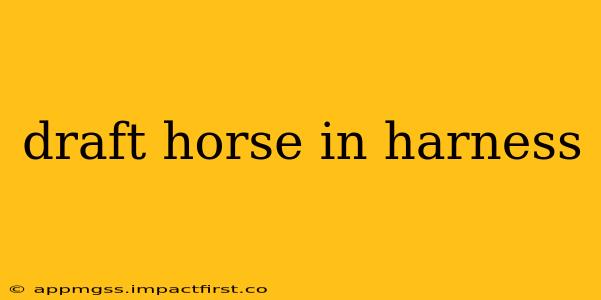Draft horses, with their immense strength and gentle nature, have long been revered for their contributions to agriculture and transportation. The sight of a draft horse in harness, pulling a heavy load with seemingly effortless grace, is a testament to the enduring power of this magnificent animal and the symbiotic relationship forged between horse and human. This article delves into the history, techniques, and importance of harnessing draft horses, answering many frequently asked questions along the way.
What is a Draft Horse Harness?
A draft horse harness is a specialized system of straps, buckles, and other components designed to distribute the weight of a load evenly across the horse's body, preventing injury and maximizing efficiency. Unlike lighter harnesses used for riding horses, draft harnesses are built to withstand immense pressure and are usually much more substantial and robust. They encompass various parts including:
- Collar: This sits around the horse's shoulders and is crucial for distributing weight. Different types of collars exist, including the horse collar (most common for draft horses) and the breast collar.
- Traces: These are the straps that connect the harness to the load being pulled, transferring the pulling force.
- Breeching: This component helps to prevent the cart or wagon from running over the horse in case of a sudden stop.
- Backband: This strap runs across the horse's back, helping to distribute the weight and provide support.
- Breastplate: While not always included, this provides extra support and prevents the harness from slipping.
What are the Different Types of Draft Horse Harnesses?
There's a surprising variety in draft horse harnesses, reflecting regional traditions and the specific tasks they're used for. While the basic components remain similar, differences lie in materials, design elements, and even the style of the buckles and decorations. For instance, some harnesses might be more elaborate, showcasing intricate leatherwork and ornamentation, whereas others prioritize functionality and durability.
How is a Draft Horse Harnesses?
Harnessing a draft horse is a skilled process requiring patience, knowledge, and attention to detail. It's a crucial step to ensure both the horse's safety and the effective execution of the task. The process involves carefully fitting each part of the harness to the horse, making sure it's snug but not restrictive. An improperly fitted harness can cause discomfort or injury to the horse.
What are the Benefits of Using Draft Horses?
Beyond their undeniable charm, draft horses offer several significant advantages:
- Strength and Endurance: They are capable of pulling heavy loads over considerable distances.
- Environmental Friendliness: They are a sustainable alternative to motorized equipment, reducing carbon emissions.
- Versatility: Draft horses can perform a wide range of tasks, from plowing fields to hauling timber.
- Therapeutic Value: Working with draft horses can be incredibly rewarding and therapeutic for both horse and handler.
How Much Weight Can a Draft Horse Pull?
The amount of weight a draft horse can pull varies depending on factors such as the horse's breed, size, age, condition, and the type of terrain. However, a strong draft horse can pull many times its own weight.
What Breeds are Best Suited for Harness Work?
Several breeds are renowned for their suitability for harness work, including:
- Belgian: Known for their strength, docility, and powerful build.
- Clydesdale: Famous for their feathering (long hair on their legs) and impressive size.
- Percheron: A strong and versatile breed with a calm temperament.
- Suffolk Punch: A rich chestnut-colored breed with excellent pulling power.
Where Can I Learn More About Draft Horse Harnessing?
Many resources exist for those interested in learning more about harnessing draft horses. Local agricultural societies, equine organizations, and experienced draft horse owners can provide valuable guidance and hands-on training.
Conclusion
The sight of a draft horse in harness remains a captivating spectacle, showcasing the remarkable bond between humans and animals. Their power, grace, and contribution to agriculture and history are undeniable. Understanding the intricacies of harnessing and appreciating the dedication involved in working with these magnificent creatures is key to preserving this important aspect of our equine heritage.
